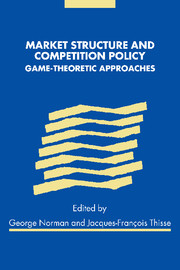Book contents
- Frontmatter
- Contents
- List of figures
- List of tables
- List of contributors
- Louis Phlips: a brief biography
- Introduction
- 1 Competition policy and game-theory: reflections based on the cement industry case
- 2 Legal standards and economic analysis of collusion in EC competition policy
- 3 A guided tour of the Folk Theorem
- 4 Predatory pricing and anti-dumping
- 5 Should pricing policies be regulated when firms may tacitly collude?
- 6 Tougher price competition or lower concentration: a trade-off for anti-trust authorities?
- 7 The strategic effects of supply guarantees: the raincheck game
- 8 Product market competition policy and technological performance
- 9 On some issues in the theory of competition in regulated markets
- 10 Modelling the entry and exit process in dynamic competition: an introduction to repeated-commitment models
- 11 Coordination failures in the Cournot approach to deregulated bank competition
- 12 How the adoption of a new technology is affected by the interaction between labour and product markets
- Index
9 - On some issues in the theory of competition in regulated markets
Published online by Cambridge University Press: 22 September 2009
- Frontmatter
- Contents
- List of figures
- List of tables
- List of contributors
- Louis Phlips: a brief biography
- Introduction
- 1 Competition policy and game-theory: reflections based on the cement industry case
- 2 Legal standards and economic analysis of collusion in EC competition policy
- 3 A guided tour of the Folk Theorem
- 4 Predatory pricing and anti-dumping
- 5 Should pricing policies be regulated when firms may tacitly collude?
- 6 Tougher price competition or lower concentration: a trade-off for anti-trust authorities?
- 7 The strategic effects of supply guarantees: the raincheck game
- 8 Product market competition policy and technological performance
- 9 On some issues in the theory of competition in regulated markets
- 10 Modelling the entry and exit process in dynamic competition: an introduction to repeated-commitment models
- 11 Coordination failures in the Cournot approach to deregulated bank competition
- 12 How the adoption of a new technology is affected by the interaction between labour and product markets
- Index
Summary
Introduction
Writing in 1962, Louis Phlips observed that ‘la réalisation d'un marché concurrentiel en Europe peut être facilitée par une intégration des marchés européens’, which is ‘un moyen d'aboutir à des comportements plus concurrentiels’, and stressed that a positive intervention may be needed in order to stimulate the forces of competition: ‘il ne suffit pas cependant de l'intégrer négativement, de se borner à la suppression des barrières artificielles aux échanges: il faut aussi l'integrer de façon positive, en améliorant son functionnement.’
While Phlips was concerned with the lowering of barriers between national markets which the Common Market was intended to demolish, the concern nowadays is with the barriers to enter certain industries, which have traditionally been monopolised: in the 1980s and 1990s, it became increasingly obvious that the simple opening up of a market to any firm which wished to enter it was not sufficient to guarantee the establishment of competitive conditions in markets for goods such as the supply of electricity, telecommunications service, water and gas. Government and competition authorities realised that they needed to maintain a degree of scrutiny over these industries, and often undertook positive actions in order to enhance the competitive pressure. The complexity of these industries throws up a host of problems which, while of considerable interest to the economic theorist, also highlight the inadequacy of a stylised view of the world according to which there are only two types of industries.
- Type
- Chapter
- Information
- Market Structure and Competition PolicyGame-Theoretic Approaches, pp. 191 - 214Publisher: Cambridge University PressPrint publication year: 2000



